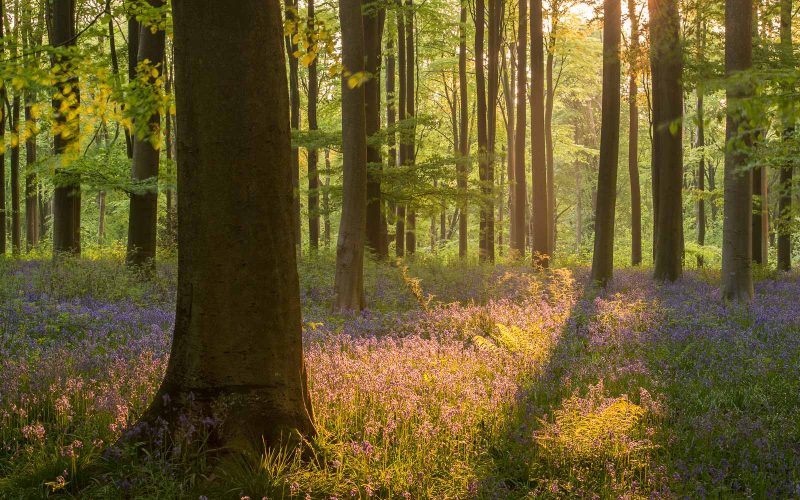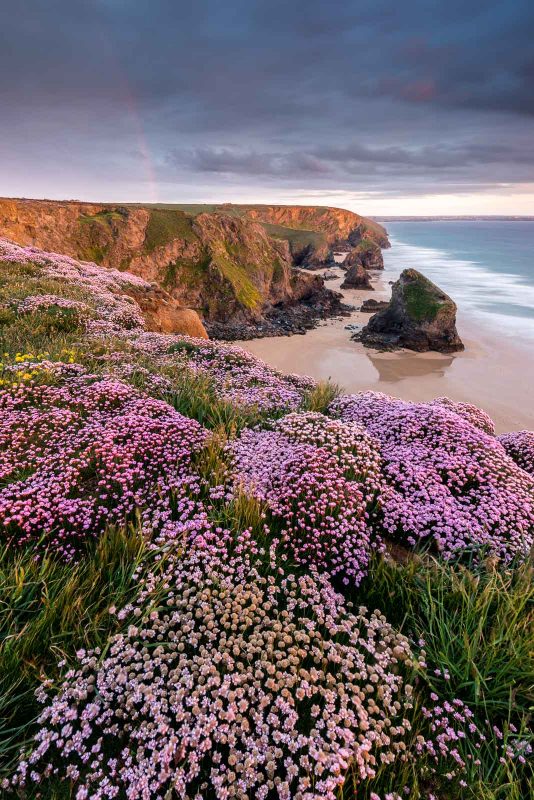How to Photograph Spring Landscapes

In my experience, wet and dreary winter weather can sap all your motivation to take landscape photographs. The days are short and cold, and the temptation to stay indoors and process images instead can be overwhelming. But now the days are growing longer and warmer, and colour and life is beginning to return to the landscape. Spring has sprung, heralding a host of great seasonal photo opportunities. Time to dust off your wide-angle lens and photograph spring landscapes.
This is the season of new life and fresh growth, transition and transformation. Throughout the months of March, April and May, the weather conditions can be hugely atmospheric. April showers can produce incredible moments of transient light and rainbows are common, while fluctuating temperatures can produce foggy and misty conditions. The countryside will be vibrant, lime green and wild flowers will carpet woodland and coastal cliff tops. It is no surprise that, for many photographers, spring is their favourite time of year.


Spring woodlands
With maybe the exception of autumn, there is no better time of year to photograph trees and woodland interiors. Foliage is vibrant green, while bluebells, wild garlic and wood anemone are among the woodland flowers that can form dense carpets of colour.
For added atmosphere, enter woodland when there is mist or fog. These conditions will simplify scenes and highlight the shape, structure and repetition of tree trunks. Low, golden sunlight will add drama to your woodland shots, particularly if you shoot toward the light’s direction in order to backlight leaves, ferns and flowers – and also capture long, inky shadows cast by trees on the woodland floor racing toward your camera.
If you are unable to visit early or late, when the light is at its best, visit when it is overcast instead. During daytime, direct sunlight can produce very contrasty, dappled light that your camera will struggle to record due to its limited dynamic range. However, cloud-cover will act like a giant soft-box, producing even and manageable light. Attach a polarising filter to reduce the glare reflecting off of glossy foliage – doing so will ensure your woodland images are saturated and punchy.
Of all the spring flowers, we associate bluebells most with the season. Few sights will engage your senses more than mature beech woodland carpeted with blooms. You can exaggerate their density by using a telephoto (in the region of 70-200m), as longer lengths appear to foreshorten perspective and thus intensify the flower’s colour.
Read more: How to Photograph Flowers in Landscapes
Spring woodland is full of colour, structure and contrast, which lends itself to creative techniques like Intentional Camera Motion (when you drag the camera during exposure to blur and soften detail) and zoom bursts (when you adjust the zoom ring during exposure to create a feeling of motion). Therefore, remember to have plenty of fun with your camera this spring.
Spring weather
Not only do fields turn green, hedgerows thicken, and trees become softened by lush fresh growth and blossom, but the March Equinox heralds changeable weather and light. The best conditions for landscape photography often occur when there is change – one season transitioning to the next, or the weather changing from good to bad or vice versa.
In the UK in particular, the weather can change rapidly at this time of year – one minute it is gloriously sunny, the next it is raining. Mist and fog are not uncommon and you might still get the odd ground frost or a flurry of snow. If the weatherman is predicting sunshine and showers, grab your camera, waterproof clothing, and a rain-sleeve for your camera and head outdoors.
When rain showers clear, the light often tends to be dramatic, particularly if there are storm clouds above and beams of spotlighting falling on the landscape below. Rain will clear the atmosphere, providing incredible clarity to your landscapes. Again, use a polariser to restore natural saturation and if there is a rainbow, a polariser will enhance its appearance – just rotate the filter until the colours appear at their strongest. To shoot weather, you need to be in position waiting for the sun to burst through the cloud. Therefore, be prepared to get wet! It is important to wear appropriate outdoor clothing and make sure you keep your camera backpack dry also. An umbrella can be useful for protecting your camera while shooting in showery conditions.
A Spring landscape or woodland will look at its most magical in misty conditions. To find out more about shooting Mist, read our article: How to Photograph Magical Mist.
Spring colour
There is an explosion of colour during springtime. Flowers – wild or cultivated crops – will provide interest, depth and impact to your landscape images. We’ve already discussed woodland flowers, but coastal cliff tops will also be carpeted in some parts during May and June. Thrift (or sea pinks) and kidney vetch are particularly photogenic, blooming in neat, photogenic clusters.
Don’t get too close to the edge of unstable cliffs, but when possible, use a wide-angle lens and include flowers as your foreground subject. Make sure blooms are in pristine condition and ideally take photographs in still weather, when flowers won’t be wind blown and blurry. Although wide-angles possess an inherently large depth of field, you will still need to select a small aperture (in the region of f/11-f16) to generate front-to-back sharpness.
Read more: 10 Tips for Sharper Landscape Photos
If you are struggling to achieve a sufficiently large zone of focus, consider taking 3 or 4 separate frames (each using a different point of focus) and then stack the images together to extend depth of field using Photoshop or dedicated software like Helicon Focus. It is always best to use a tripod when focus stacking.
Cultivated crops of daffodils, tulips, opium poppies, oilseed rape and lavender will prove just as effective for adding colour impact to your landscape images. Flowers have the ability to add texture, context and seasonal flavour to your images. A deep blue, polarised sky will add further punch to your shots. A polarising filter’s effect is at its most pronounced at a 90-degree angle to the sun. However, the effect of the filter can be very seductive through your camera’s viewfinder. Be careful not to over-polarise scenes (when skies grow artificially dark) and also beware uneven polarisation, when the sky looks darker in some parts more than others. The effect of uneven polarisation is most obvious when using a wide-angle lens to photograph a scene with a cloudless sky.
Deep blue skies and vibrant green vegetation not only suit colour, but infrared photography too. For more information, read our article: Infrared Photography: The Invisible Light.
So what is stopping you? Grab your camera and step out outside to capture all the seasonal wonders spring has to offer…










